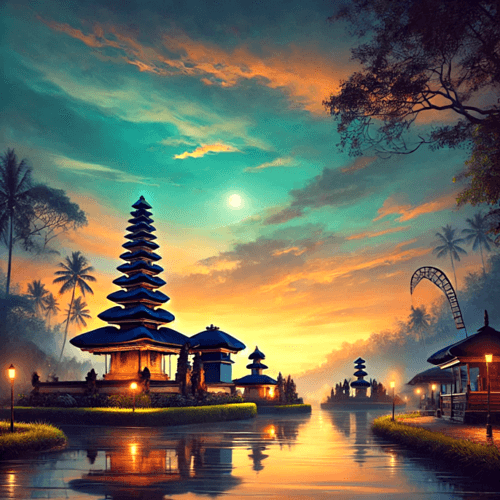A journey to the spiritual heart of Bali, where ancient stone meets the clouds and the gods are revered.
Discovering Besakih Temple: The Mother Temple of Bali
Perched 1,000 meters above sea level on the southwestern slopes of Mount Agung, Besakih Temple (Pura Besakih) is Bali’s largest and holiest temple complex. Known as the “Mother Temple,” it is a place of great spiritual significance and serves as the central point of worship for Balinese Hindus. Its unique location and sprawling layout, with more than 80 individual temples, make it one of the most awe-inspiring cultural landmarks on the island.
Besakih Temple offers a rich cultural experience for visitors, blending stunning natural landscapes with intricate architectural and spiritual beauty. Whether you are a casual tourist or deeply interested in Balinese culture, a visit to Besakih provides an unforgettable journey into Bali’s ancient traditions.
The History and Significance of Besakih Temple
Besakih Temple has a long history that dates back over 1,000 years. Legend has it that the temple’s origins can be traced to the 8th century, when a Javanese Hindu priest, Rsi Markandeya, arrived in Bali and established this sacred site. Over the centuries, it expanded to become Bali’s primary temple, a testament to the island’s religious and cultural evolution.
The temple complex sits at the foot of Mount Agung, Bali’s highest and most revered volcano, believed to be the abode of gods and spirits. The spiritual connection between Mount Agung and Besakih enhances its religious significance, and the temple is often the center of large religious ceremonies and pilgrimages.
Besakih Temple’s importance goes beyond its spiritual function—it’s also an architectural masterpiece. The complex features tiered pagodas (known as Meru), stone shrines, and intricately carved gateways, all arranged in a multi-tiered layout ascending toward the mountain. Each of the sub-temples has a specific role, dedicated to different deities and aspects of Balinese cosmology.
The Layout and Main Temples of Besakih
The Besakih Temple complex is vast, and you could easily spend hours exploring its many shrines and sub-temples. However, the heart of the site revolves around Pura Penataran Agung, the largest and most important temple in the complex. This temple is dedicated to the Hindu Trinity—Brahma, Vishnu, and Shiva—and features a grand staircase leading to seven terraces, representing the seven layers of the universe in Balinese belief.
Other key temples within the complex include:
- Pura Batu Madeg: Associated with Lord Vishnu, this temple is located to the west and features ancient stone relics believed to have spiritual power.
- Pura Kiduling Kreteg: Dedicated to Lord Brahma, this temple lies to the east of the complex and is often the site of important ritual offerings.
- Pura Pasimpangan and Pura Peninjoan: These temples offer panoramic views of the surrounding area, including breathtaking sights of Mount Agung, especially during clear mornings.
Experiencing the Spiritual Atmosphere
Visitors to Besakih Temple are encouraged to respect the temple’s spiritual atmosphere. The temple remains an active place of worship, and it’s common to see Balinese people participating in prayer, rituals, and offering ceremonies, known as canang sari. These offerings are a colorful sight, typically made of flowers, rice, and incense, placed at various shrines to honor the gods.
Before entering the temple, visitors are required to wear a sarong and sash to show respect for the sacred site. These can often be rented or borrowed at the entrance if you don’t have your own.
A visit during one of the temple’s many ceremonies, such as Galungan or Kuningan, will allow you to witness vibrant traditional celebrations, complete with colorful decorations, music, and processions of Balinese people dressed in their finest attire. However, even outside of festival periods, Besakih remains a tranquil place for meditation and reflection.
TIP: The best time to visit Besakih Temple is early in the morning, not only to avoid the crowds but also to catch a clear view of Mount Agung, which is often shrouded in clouds later in the day.
Practical Information for Visiting Besakih Temple
Weather Preparedness: Perched on the slopes of Mount Agung, Besakih is often shrouded in mist, giving it a mystical feel. However, weather can change quickly here, so bring an umbrella or light rain jacket—light showers are common and add to the temple’s dramatic atmosphere!
Explore with a Guide: With over 80 sub-temples, Besakih can feel overwhelming. Hiring a local guide is highly recommended and can enrich your visit. Guides, many of whom are devotees, share fascinating insights into the temple’s history, rituals, and cultural symbolism—something you might miss on a self-guided tour. Be mindful to look for official guides rather than unofficial “helpers” near the entrance, who may offer services or goods without prior arrangement.
Respect the Sacredness: As an active place of worship, Besakih requires visitors to wear a sarong and sash, both symbols of respect in Balinese culture. These can be rented or borrowed at the entrance if you don’t have your own. Visiting during ceremonies like Galungan or Kuningan is a special opportunity to witness traditional rituals with music, decorations, and locals dressed in vibrant attire.
Getting There: Besakih is about two hours by car from Ubud and three hours from Kuta or Seminyak. Hiring a private driver or joining an organized tour is recommended for comfort, as public transportation options are limited. Along the way, enjoy scenic views of rice terraces, local villages, and winding mountain roads. For those interested in trekking, Besakih is also part of the Mount Agung hiking route—but keep in mind this requires careful planning and an experienced guide due to volcanic activity.
Travel Prep: Comfortable walking shoes are a must due to the temple’s steep paths.
Best Time to Visit: Early morning for fewer crowds and clear views of Mount Agung.


















